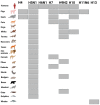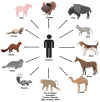Zoonotic Animal Influenza Virus and Potential Mixing Vessel Hosts
- PMID: 37112960
- PMCID: PMC10145017
- DOI: 10.3390/v15040980
Zoonotic Animal Influenza Virus and Potential Mixing Vessel Hosts
Abstract
Influenza viruses belong to the family Orthomyxoviridae with a negative-sense, single-stranded segmented RNA genome. They infect a wide range of animals, including humans. From 1918 to 2009, there were four influenza pandemics, which caused millions of casualties. Frequent spillover of animal influenza viruses to humans with or without intermediate hosts poses a serious zoonotic and pandemic threat. The current SARS-CoV-2 pandemic overshadowed the high risk raised by animal influenza viruses, but highlighted the role of wildlife as a reservoir for pandemic viruses. In this review, we summarize the occurrence of animal influenza virus in humans and describe potential mixing vessel or intermediate hosts for zoonotic influenza viruses. While several animal influenza viruses possess a high zoonotic risk (e.g., avian and swine influenza viruses), others are of low to negligible zoonotic potential (e.g., equine, canine, bat and bovine influenza viruses). Transmission can occur directly from animals, particularly poultry and swine, to humans or through reassortant viruses in "mixing vessel" hosts. To date, there are less than 3000 confirmed human infections with avian-origin viruses and less than 7000 subclinical infections documented. Likewise, only a few hundreds of confirmed human cases caused by swine influenza viruses have been reported. Pigs are the historic mixing vessel host for the generation of zoonotic influenza viruses due to the expression of both avian-type and human-type receptors. Nevertheless, there are a number of hosts which carry both types of receptors and can act as a potential mixing vessel host. High vigilance is warranted to prevent the next pandemic caused by animal influenza viruses.
Keywords: animal influenza; avian influenza; interspecies transmission; mixing vessel hosts; pandemic; public health; swine influenza; zoonoses.
Conflict of interest statement
The authors declare no conflict of interest.
Figures




Similar articles
-
Recent zoonoses caused by influenza A viruses.Rev Sci Tech. 2000 Apr;19(1):197-225. doi: 10.20506/rst.19.1.1220. Rev Sci Tech. 2000. PMID: 11189716 Review.
-
Avian influenza in swine: a threat for the human population?Verh K Acad Geneeskd Belg. 2006;68(2):81-101. Verh K Acad Geneeskd Belg. 2006. PMID: 16800240
-
Evolution of influenza A viruses in exhibition swine and transmission to humans, 2013-2015.Zoonoses Public Health. 2024 May;71(3):281-293. doi: 10.1111/zph.13104. Epub 2023 Dec 18. Zoonoses Public Health. 2024. PMID: 38110691 Free PMC article.
-
[Swine influenza virus: evolution mechanism and epidemic characterization--a review].Wei Sheng Wu Xue Bao. 2009 Sep;49(9):1138-45. Wei Sheng Wu Xue Bao. 2009. PMID: 20030049 Review. Chinese.
-
The role of swine in the generation of novel influenza viruses.Zoonoses Public Health. 2009 Aug;56(6-7):326-37. doi: 10.1111/j.1863-2378.2008.01217.x. Zoonoses Public Health. 2009. PMID: 19486316 Review.
Cited by
-
Comparative analysis of epidemiological and Spatiotemporal patterns in seasonal influenza and COVID-19 outbreaks.Sci Rep. 2025 Mar 12;15(1):8602. doi: 10.1038/s41598-025-93372-z. Sci Rep. 2025. PMID: 40075172 Free PMC article.
-
Detection of a Reassortant Swine- and Human-Origin H3N2 Influenza A Virus in Farmed Mink in British Columbia, Canada.Zoonoses Public Health. 2025 May;72(3):293-300. doi: 10.1111/zph.13205. Epub 2024 Dec 29. Zoonoses Public Health. 2025. PMID: 40178199 Free PMC article.
-
Increasing spillover of highly pathogenic avian influenza A (H5N1) virus to mammals.New Microbes New Infect. 2024 Aug 19;62:101459. doi: 10.1016/j.nmni.2024.101459. eCollection 2024 Dec. New Microbes New Infect. 2024. PMID: 39253406 Free PMC article.
-
Differential TLR-ERK1/2 Activity Promotes Viral ssRNA and dsRNA Mimic-Induced Dysregulated Immunity in Macrophages.Pathogens. 2024 Nov 23;13(12):1033. doi: 10.3390/pathogens13121033. Pathogens. 2024. PMID: 39770293 Free PMC article.
-
Preparedness, prevention and control related to zoonotic avian influenza.EFSA J. 2025 Jan 29;23(1):e9191. doi: 10.2903/j.efsa.2025.9191. eCollection 2025 Jan. EFSA J. 2025. PMID: 39882189 Free PMC article.
References
-
- Kuhn J.H., Adkins S., Alioto D., Alkhovsky S.V., Amarasinghe G.K., Anthony S.J., Avšič-Županc T., Ayllón M.A., Bahl J., Balkema-Buschmann A., et al. 2020 taxonomic update for phylum Negarnaviricota (Riboviria: Orthornavirae), including the large orders Bunyavirales and Mononegavirales. Arch. Virology. 2020;165:3023–3072. doi: 10.1007/s00705-020-04731-2. - DOI - PMC - PubMed
-
- Suarez D.L. Animal Influenza. John Wiley & Sons, Inc.; New York, NY, USA: 2016. Influenza A virus; pp. 1–30.
Publication types
MeSH terms
LinkOut - more resources
Full Text Sources
Medical
Miscellaneous

